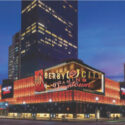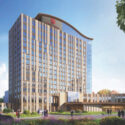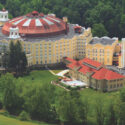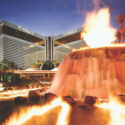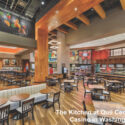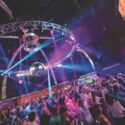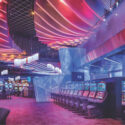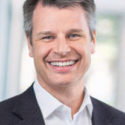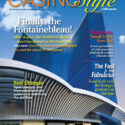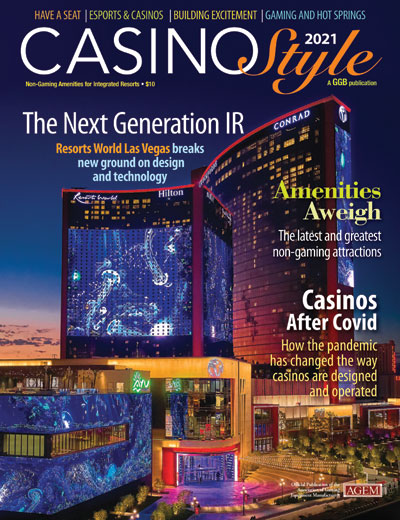
Ten years in the making, Resorts World Las Vegas had the luxury of responding to trends that emerged during that decade.
The property was formerly home of the Stardust, an iconic casino of old Las Vegas. It was owned at the end by Boyd Gaming, which wanted to take what it learned building the Borgata in Atlantic City and translate it to the Strip. Boyd’s planned Echelon resort would capitalize on all the progress made in gaming since the Borgata opened in 2003. It would be state-of-the-art, with all the non-gaming amenities that had begun to rule in destination resorts.
Then the recession hit, and Boyd’s well-laid plans were scuttled. Construction on Echelon was halted after a parking garage and a podium had been developed. And there it languished for several years.
Along came Genting Berhard. The Malaysian gaming conglomerate, controlled by the Lim family, had financed construction of Foxwoods in Connecticut and the Seneca casinos in upstate New York, and wanted a greater U.S. presence. Genting needed a Strip presence for its Resorts World brand. And what better place to plant a flag than the former Stardust site?
Genting hired noted architectural firm Steelman Partners, headed by Paul Steelman, to incorporate what Boyd had already done into a master plan for development.
“(Genting Chairman) KT Lim is probably one of the most ingenious real-estate developers who has ever set foot in Las Vegas, and has ever designed an integrated resort,” says Steelman. “If you know his style, he loves master-planning.
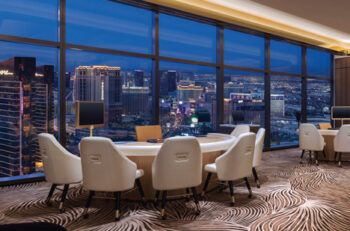
The private gaming salon, Starlight on 66 Sky Gaming
“Consequently, what we did was shrink the overall footprint of the Echelon podium to allow for about 40 acres—that’s twice as large as the Fontainebleau site, and could in fact be master-planned for future growth. Expansion opportunities sit on every side of the property—on the north, towards Circus Circus; on the east, towards the Convention Center and Las Vegas Boulevard; on the south, for a series of pools and all sorts of unusual activities; and on the west, where it can be convention, meetings or any of those sorts of activities.”
The first design iterations were heavily Chinese-themed. Plans were announced for a “Great Wall” at the entrance, with a contemporary interior that reflected modern China. The plan even included a panda pavilion. But that plan eventually went away.
“Around the beginning of 2019, it was decided to even deemphasize the modern Asian interiors except in a few spots, such as the Genting Palace restaurant and bar,” Steelman says. “But we just felt the modern approach was the best.”
Decade of Change
As the first new resort on the Las Vegas Strip in 10 years, Genting understood that it had to create something spectacular.
“I don’t want to say ‘raising the bar,’ because it was creating a different bar,” Steelman says. “So we tried to create something different. We wanted to be sure the casino was energized. It’s wider. It’s brighter. I get a lot of comments. People say to me, ‘Paul, you’ve made a lot of (other properties) look pretty old on the Strip as we walk through this place.’”
Everything coalesced in 2019, when Scott Sibella was appointed president and CEO of Resorts World Las Vegas.
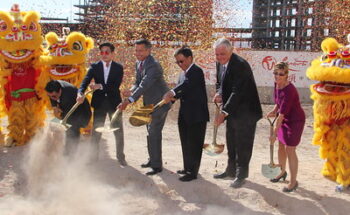
The official groundbreaking for Resorts World Las Vegas took place almost seven years ago with KT Lim and his son, along with two Nevada governors.
“I’ve worked on a lot of projects in my life, and this was a nine-year, two-month adventure for me,” Steelman says. “Mirage was only four years. So think about it—it was twice as long. Scott came in two and a half years prior to opening, and he managed to pull it together.”
For Sibella, the long time span in designing the property became a positive.
“Being the first resort to be built on the Strip in more than a decade, we had a natural advantage to become the most modern, technologically advanced property in the city,” he says. “The Genting team has brought international perspective and family-owned culture to Las Vegas, giving guests a truly integrated resort experience, and adding a totally new dynamic to the city. We feel we add something fresh and exciting to the overall Las Vegas experience.”
Over that period, there were many design changes, including in retail and food and beverage.
“We’re pretty confident in that architectural design direction today,” Steelman says. “That led us to create The District, a very tall, large daylit shopping center. The whole idea was to have a neutral palette to allow tenants to express their own architecture, within a reasonable sort of way. One thing that survived our Chinese scheme was the digital sphere, a very unique looking-glass ball. Is it a fountain, with a looking glass?”
The District has been a big success since Resorts World’s opening in June 2021, says Sibella.
“While it’s hard to measure which area of the property is the most popular, we’re seeing a lot of success in The District, our shopping, retail and entertainment promenade,” he says. “The District is home to many of our popular retail stores, including Fred Segal, Pepper, Sneaker Garden, Twila True and more. Hotel guests and visitors alike are loving the retail options and the variety of places they can shop.
“Also within the same area are a few of the resort’s signature restaurants, such as our Mexican restaurant, VIVA by Ray Garcia; Fuhu, an Asian vibe-dining restaurant from our partners at Zouk Group; Brezza, serving coastal-Italian fare from local chef Nicole Brisson; and more. The District houses Zouk Nightclub, which has been a major success since its opening, and Ayu Dayclub, our poolside daylife venue.”
Wayfinding
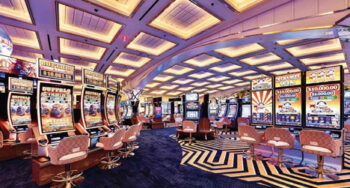
The casino at Resorts World Las Vegas will accept cashless transactions at all machines and tables.
Resorts World Las Vegas is a big property. With more than 3,500 rooms, a 117,000-square-foot casino and dozens of restaurants, shops and clubs, the $4.3 billion facility is massive. Often, it’s difficult to navigate a property of that size. But not so with Resorts World, according to Sibella.
“Although the resort is large, it was designed to be easily navigated,” he says. “All hotel lobbies have their own entrances, so there’s no need to walk through the casino to get to a guest room. All guest elevators lead directly to the pool, spa and meetings and event space, allowing for quick commutes around the various areas of the resort.
“The property is essentially a large loop, with clear signage directing guests to different venues. To also assist with wayfinding, each hotel brand—Las Vegas Hilton, Conrad Las Vegas and Crockfords Las Vegas—have distinctive design and color palettes to differentiate from one another, making it extremely clear as you enter a different hotel.”
Steelman says he relied on his experience designing other properties to minimize the distances. “We’ve found over the years that your visit will be shortened if you don’t see a clear way to leave. Casino gaming needs interaction, whether it be with slot machine, people, tables or whatever. We always felt that a linear casino could organize everything a lot better than in the old days, where we were curving the casino. So we feel that’s a planning advantage of Resorts World. It’s a very organized orientation that people feel comfortable in. And people look good in it—that’s a big thing, that people look good in the building.”
Even without a destination in mind, Resorts World is designed to amaze and amuse guests at every turn.
“I absolutely encourage guests to walk the property and experience all it has to offer,” says Sibella. “There’s so much to see that it’s almost difficult to take everything in during one quick visit. I think the sheer size and how stunning the resort alone is; it’s impressive—with such a wide selection of offerings and so much to experience, nobody is left out, and everyone can find something to enjoy on our campus and feel welcome. The intimacy, even within such a massive resort, is a major factor of the property.”
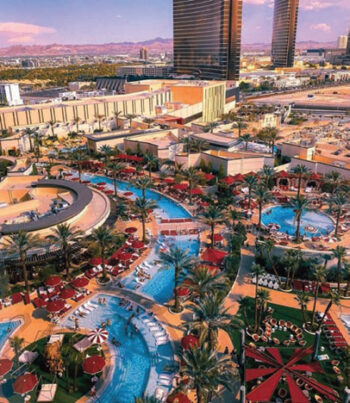
Just some of the nine pools offered by Resorts World
The three hotel brands are distinctive as well. The main hotel, a Hilton, offers more than 1,700 entry-level rooms. Then it’s a step up to the Conrad, with almost 1,500 rooms. The luxury brand, Crockfords, has 236 rooms and suites. Crockfords was acquired by Genting when it bought the historic London casino of the same name more than a decade ago. The name isn’t well known in the U.S., but Sibella says Resorts World will change that.
“Crockfords is our top-tier, premium hotel brand, with luxe accommodations and VIP offerings,” he says. “Those looking to elevate their trip are choosing to stay at Crockfords and enjoy the lavish feel of the arrival journey, suites and service. Although Crockfords is new to the domestic market, those searching for high-end accommodations are staying there to experience the city’s newest luxury hotel.”
Each hotel has a different arrival experience, and Crockfords needed to stand out.
“The way we master-planned enabled us to create three distinctive lobbies, architecturally,” Steelman says. “We took a page out of what we’ve been doing in Asia. It’s the right thing to do: three porte-cocheres, three entrance points, three statements. We put Crockfords in a strategic location, because it had to relate to VIP gaming, very close to the high-limit gaming areas and the Asian restaurants.”
Spectacular pools and spas are a must in any new Las Vegas property these days, and Resorts World doesn’t disappoint. With 5.5 acres at his disposal, Steelman turned the design process over to Lifescapes International, his partner in almost every project since late Lifescapes founder Don Brinkerhoff designed the volcano at the Mirage.
“I convinced KT to choose Don Brinkerhoff. He was one of the great innovators, and of course he’s in the AGA Gaming Hall of Fame—probably the only design professional who is. And his team, headed by his daughter Julie, did a fantastic job on this particular project.”
The result is nine pools, including the only infinity pools on the Strip with views of the skyline. Reservations are required, and there is an adults-only policy.
One of the pools is the Ayu Dayclub, operated by the Zook Group, headed by Lim Lui, KT’s son. Resident DJs include Zedd and Tiesto.
Entertainment also is a focal point of Resorts World Las Vegas, with a state-of-the-art theater built by Scéno Plus, to be operated by AEG Presents. The 5,000-seat Theater at Resorts World will host residencies by such stars as Carrie Underwood, Celine Dion, Katy Perry and Luke Bryan.
Technology Tests
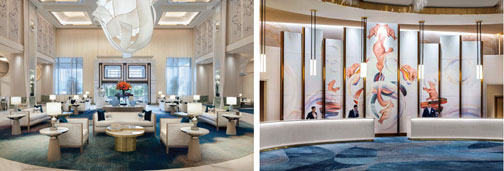
Each of the three hotels has a different lobby with a different arrival experience, such as the luxury brand Crockfords.
A standout feature of Resorts World Las Vegas is the cutting-edge technology built into every element of the property. Again, Sibella says the long design period turned out to be a benefit when it comes to tech.
Much of the technology is attached to the Genting Rewards club, where guests can pay for anything on the property with one wallet, including on the casino floor. Partnerships with companies like Konami, Sightline, IGT and others have made the process seamless. Sibella says customers have been appreciative of the technology so far.
“Guests who are ready for a new generation of gaming and cashless capabilities have been eager to sign up for Genting Rewards,” he says. “The rewards program was designed to allow guests to earn points, recognition and rewards for all spend across the resort, all easily accessible through the Resorts World app. We’re encouraging signups through signage across the property, email and website marketing efforts, and verbal mentions when guests meet with our team members who can provide more information on the program.”
Steelman utilized new LED technology to create a huge billboard on the main building. The 100,000-square-foot exterior LED screen measures 294 feet in height and 340 feet in width, and is made of a semi-transparent aluminum mesh that allows guests to see through the windows, even while it’s operating.
He says the technology will become one of the signatures of the property.
“Scott Sibella and his technology team did a wonderful job of making an advanced casino,” he says. “We had to tailor-make some of our tables and slot machine designs to accomplish these goals. These goals are admirable. (Guests are) using their Resorts World digital wallet to buy almost everything in the place. And I give KT the credit for authorizing Scott to go for it.
“Of course, we see the technology in our hotels changing rapidly. Our front desks are getting smaller, there are no room keys; you’re holding out your phone. We’re seeing RevPAR trying to be established by holding up your phone to the various activities within the hotel room. We’re limiting the touch points in all our buildings and maximizing the phone integration. And that’s just going to be the wave of the future.”
Sibella acknowledges that it may take some time for full adoption, but he’s encouraged by the initial response.
“While we knew customer adoption of cashless technology would be achieved over time, more and more guests are utilizing the technology and becoming more familiar with our cashless gaming capabilities and integrating it into their experiences,” he says. “We feel it will take time for everyone to adapt and fully understand the capabilities, but so far we’re seeing a positive response.”
He says none of it could have been accomplished without terrific cooperation with his vendor partners.
“When developing our gaming technology for the resort, we only wanted to work with the best in the business to make our vision come to life,” Sibella says. “Working with great technology companies like Konami, Sightline, IGT and more has been instrumental to the success and seamless integration of our casino technology. They have been fantastic partners and the collaboration is going well.”



